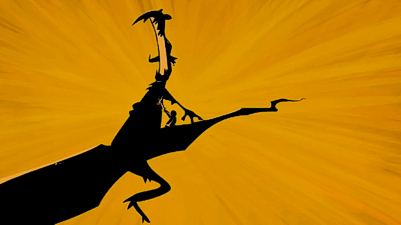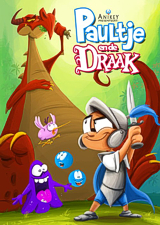Paul & The Dragon
by Ben | April 13, 2009 10:04 am
 |
| Brave young lad Paul arrives at hospital for the beginning of his real and imaginary adventures |
Although it never seems to get the recognition it deserves, the Netherlands region of our world has long been rich in strong animation connection, from Ivo Caprino’s mechanical and stop-motion puppetry and the work of talented artists such as Best Animated Short Oscar winners Borge Ring and Michael Dudok de Wit, to the recent world-class quality feature animation of A-Film, responsible for the delightful Help! I’m A Fish and that little Gaul’s recent adventure Asterix Versus The Vikings.
Of course I am generalising, but then sadly so does the rest of the world: much of these efforts often get lumped simply in a broad “European” category, but bringing a little attention specifically to Holland is the new animation studio AniKey, founded by directors Paco Vink and Albert ’t Hooft to create their first animated featurette, Paultje en de Draak.
The aims behind the film couldn’t be simpler or for a better cause, uniquely using animation to help children aged between 5 and 13 suffering with cancer, and their parents, to cope with battling the decease. It does this in two very clear and intelligent ways, first presenting the affected lad Paul as a highly imaginative young man whose escape into a fantasy world of his creation is threatened by a hugely grumpy old dragon, thus generating evident parallels between his situation back in the real world and his dream land. Secondly, and also in a bid to present the film on the international stage, Vink and Hooft have devised their film as a complete pantomimed experience, the result being that the action is amazingly concise and clear to follow as well as highlighting the film’s intentions.
Simplicity is the key here, with lots of exposition being literally drawn out by Paul’s supervising Doctor (Vink and Hooft show their animation history amusingly by naming the Doc’s colleagues Jones, Avery and Clampett in an early scene). Having been diagnosed, Paul is sent to hospital, a quite airy and bright place that’s nicely designed so as not to present a foreboding illustration for children who might be facing the same prospects. As he enters a program of treatment, his mind, inspired by the toys left by his window, wanders further and further into an imaginary forest, where events somewhat mirror those in the hospital.
So, as Paul is given treatment, we meet the characters inside the forest who come to assist him in the battle to slay the Dragon: the purple Chemo Blob isn’t so smart but comes in useful at the right times, reflective of chemo therapy’s powers, while the sprite-like blue Medics act like the Blob’s guides, performing tasks similar to antibiotics and cel regeneration, keeping Paul’s forest as safe as can be. The Dragon itself is, of course, the cancer, a nasty and dangerous monster that is only all too easily led by its one-track mind to eat, destroy and set fire to the forest, all the time becoming bigger and meaner. Taking on the role of a knight, Paul ventures into the forest to take on this beast, refusing to become a bystander to this terrible threat and leaping into a proactive position to assist in doing all he can to combat the danger. In the real world, this shows up as Paul’s determination to pull through his crisis, supported by his friends and family.
 |
| Dragon defeated! Paul’s heroic self is victorious in beating his illness |
Paul himself is great: a real young boy, verging on being a teenager, and slow to wake up to the realisation that there’s something serious happening to him. He’s first seen out in the park, enjoying his youth, and when he starts to feel ill, he reacts as any child might: he doesn’t want to visit the hospital, angry that he has to be there, bored while he’s waiting to be seen, and afraid of the many tests that need to be carried out.
Like most kids, Paul’s only really interested in having fun, something the Doctor picks up on immediately, turning everything into a bit of a game, from the first scans Paul undergoes, to a Nurse offering him candy as a diversion from another test and the Doc’s stick-figure description of what’s happening, while the moment it dawns on Paul that he really is ill is played poignantly.
But this isn’t any hum-drum, overbearingly “worthy” or “instructional” kind of film: despite the strong signals it sends, Paul & The Dragon skilfully works as an entertainment, providing close to a half-hour’s worth of tried and tested adventure heroics, the added aspects to the story simply providing another unique layer of interest. It works on many levels: although cancer is the driving force here, it’s not the actual subject of the film, which deftly brings Paul in as its central focus. The lack of spoken dialogue makes a strong argument for screening the film to any children who face long-term medical conditions, and I’d expect some nervous adults would gain pleasure and a certain reassurance from the hero’s overcoming his illness too.
More importantly, the illness itself is never called upon as a reason to make us feel sad about Paul’s situation: naturally we are concerned, but apart from one brief moment when the young lad is feeling sorry for himself but quickly chooses to fight back, Paul & The Dragon is only really interested in life. It works as a short film that one can actually enjoy irrespective of having to think too heavily about cancer, illness or any other; the bottom line is that Paul is sick, and he needs to get better. If escaping into his own world is a benefit to him that makes this happen, then that’s a great thing, and the climactic defeating of his Dragon foe is as classic as animation gets, with shades of the biggest dragon battle sequence of all, from Sleeping Beauty, paid homage to in the staging.
Helping all this come together very convincingly is the full hand-drawn animation, created in-house by the extremely competent team at AniKey Studios. Created in a storybook sketch style, the approach sees some wonderfully illustrative backgrounds that serve the character animation well. Paul and his friends have all been given a great deal of life and zest, reflected in the zippy movements all the characters exhibit: even when the production does have to sit back on some animation tricks it does so without resorting to recycling limited animation, and some of the CG touches are really quite nicely integrated. I was reminded, on a similar level, by the quality of the Rex Steele short from a few years back, and by Don Bluth’s work in the Dragon’s Lair games footage. A very neat scene in which Paul’s plight is spelled out to him using animated stick figures is also wisely achieved with more than a touch of, if not exactly comedy, a lightness that still displays a strong hand, immensely achieved with the help of Maarten Spruijt’s sprightly musical score.
 |
| Animation test: this pitch reel is among the early concepts revealed on the DVD |
Inspired by the story of a real life boy, Paul Sanders, who had cancer at the age of ten and survived, Paul & The Dragon premiered on DVD and was distributed throughout hospitals in Holland on February 15 2009, the International Childhood Cancer Day, with copies available in the European PAL format for a nominal fee. The region-free factory pressed DVD is as professional a product as the film itself, with a delightful insert (in Dutch) that outlines the ambitions for the featurette and describes its characters, and colorful disc art that replicates one of the film’s key poster sheets.
On the disc itself, Paul & The Dragon is shown in its originally created 1.78:1 anamorphic widescreen ratio, a clinically crisp digital transfer that still retains a film-like presence. Language options are naturally not an issue, and finding one’s way around the menus is easy, the soundtrack in both Dolby 5.1 and 2.0 Stereo being easily identifiable. Even better is a small supplement of extras, including a full two-minute trailer for the movie, which sets up the basic plot and the fun within (still without dialogue but with some minimal Dutch intertitles) and a 2005 animation test lasting around 60 seconds which served as a pitch reel in proposing the project to investors.
AniKey’s animation process is shown in a series of two silent shots which progress from rough pencil test, through cleanup and final color, and a video stills Gallery presents two minutes worth of concept drawings, character designs and background art, all of it very interesting to see. Finally, a 15 minute “moving storyboard” presents the film in animatic form, incorporating the pitch test at the appropriate moment. Noticeable in the test is a slightly rougher animation style (similar to the Xerox approach of the 1960s) and a different Paul, a little more realistic and not quite as appealing as how he appears in the final version, but all the heart and emotion are still very much apparent even at this early stage.
Paco Vink and Albert ’t Hooft’s film isn’t the first to serve up a visual description of serious illness as a more palatable occurrence, but it’s certainly one of the most successful I’ve ever come across. Though it might be said, if any real criticism could ever be levelled at such a well-intentioned project produced for such a good cause, that their film could have perhaps been a little tighter and come in with more impact at 15-20 minutes, perhaps later commercial television sale potential dictated the usual 23 or so minute length. Nevertheless, here’s hoping that such a TV sale, or indeed practical international recognition with English-language title cards via a US distributor, is in the film’s prospects: it certainly ought to be seen much farther than just in its native Holland, and might vastly benefit children all over the world with its strong messages and highly visual quality storytelling.
I’m not sure how or if it would qualify for the Academy Awards, but I do hope Paul & The Dragon officially receives some much deserved awards kudos, if for the achievement alone. Whatever else, AniKey Studios have shown they are a new name to keep an eye on in the future.
 |
Paul & The Dragon
AniKey Studios (2008) February 15 2009 24 minutes Not Rated directed by Paco Vink and Albert ’t Hooft
|
Paul & The Dragon is distributed in Holland by the Dutch Childhood Cancer Parent Organisation VOKK[1], a national organisation of parents of children with cancer, offering information and help to other parents, schools and guardians for children suffering with cancer.
The Paul & The Dragon DVD is available from the VOKK[2] for 5 Euros, which goes to the organisation. International orders should email this address: bureau(at)vokk.nl but remember that the DVD is in PAL format with Dutch text.
AniKey and their producers il Luster Films[3] are keen to secure international distribution for their film. If you represent an organisation similar to the VOKK in your country that may be interested in distributing Paul & The Dragon to children, schools and hospitals, or able to sponsor the translating and printing of the DVD package’s text into other languages, please contact info(at)illuster.nl for details.
More information on the film’s creators and other projects can be found at the AniKey Studios website[4].
Visit Paul & The Dragon’s Dutch/English language website[5] for a look at the film’s production process and trailer.
- Dutch Childhood Cancer Parent Organisation VOKK: http://www.vokk.nl/website/eng/information_in_english/index.html
- DVD is available from the VOKK: http://webwinkel.vokk.nl/index.cfm?fuseaction=publiek_product.detail&pro_id=116
- il Luster Films: http://www.illuster.nl/?language=2
- AniKey Studios website: http://www.anikey.nl/
- Paul & The Dragon’s Dutch/English language website: http://www.paultjeendedraak.nl
Source URL: https://animatedviews.com/2009/paul-and-the-dragon-film-and-dvd/